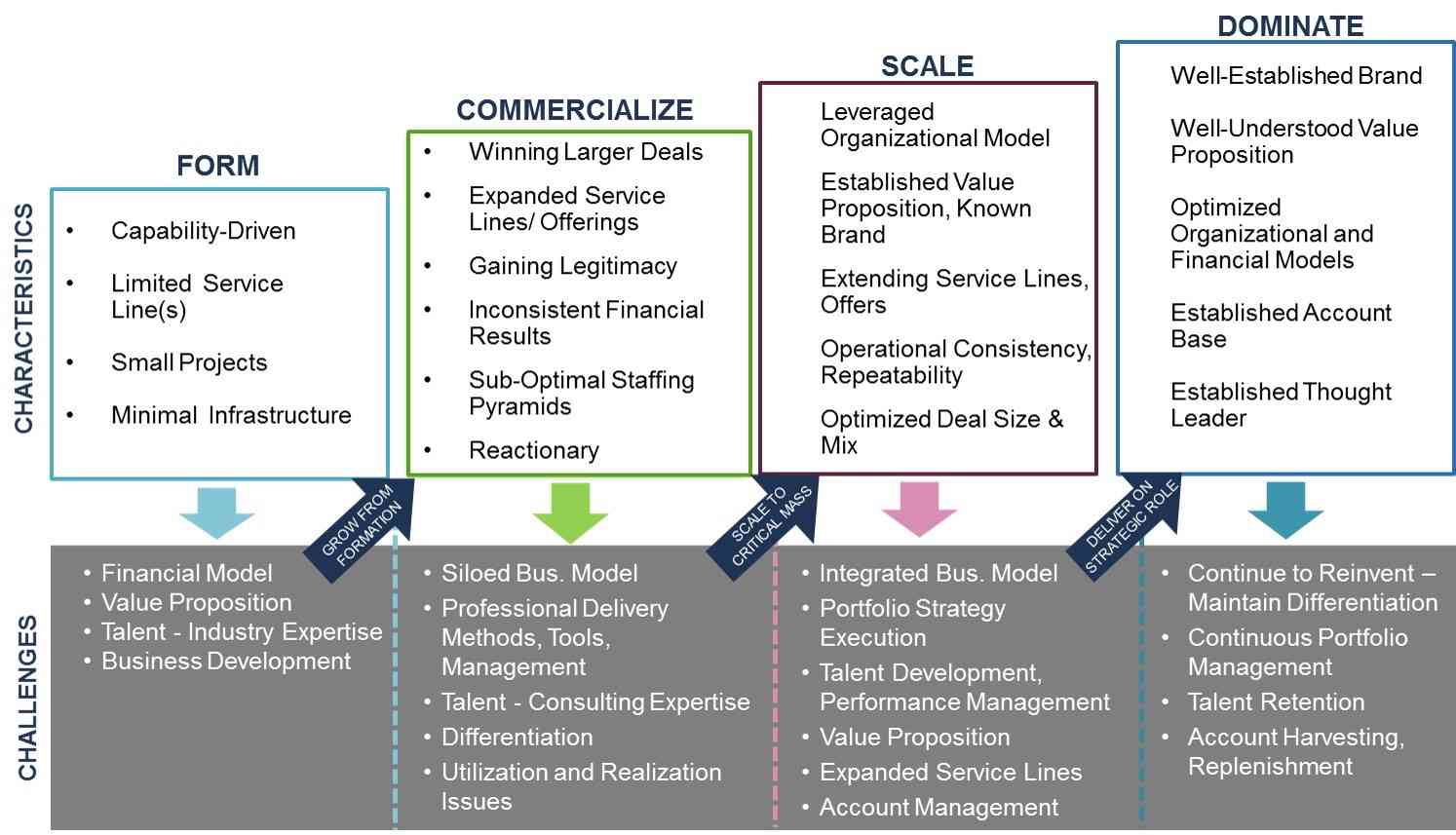Building Customer Intimacy with the market and leveraging those relationships as a mechanism to grow share-of-wallet at your existing accounts and open doors at new accounts requires more than just new sales approaches and good relationships. Truly realizing a Customer Intimacy strategy as a competitive advantage takes a commitment to a new way to do business – not just a new way to engage the market. As a result, getting started is often challenging, especially if you are not the CEO or the executive with authority to directly move the organizational strategy.
The first step to embarking on this evolution is making the case for change to obtain the necessary buy-in both up and down organization to lay the foundation for a successful model shift.

We believe this occurs in three steps:
- Determine whereyour company is in the journey,
- Identify your next specific stepsin the journey, and
- Motivatethe organization to take action.
All three steps are critical and the effort to accomplish them should not be minimized. The following sections explore each of these steps and introduce some key best practices for how they might be best achieved.
Step 1: Where Are You on the Customer Intimacy Journey?
Of course, you must understand where you are in the journey before you begin to motivate the organization. As you know, and we have experienced, companies have been struggling with commoditization for a long time, but not all find themselves in the same place on the journey to overcoming the challenges it causes. Some organizations find themselves in the ‘Form’ stage and have not yet experimented with any of the Customer Intimacy concepts, while most have taken tentative steps even if they do not fully understand the journey.
The following are a few simple questions to assist in assessing your progress on the journey. The point of these questions is to help you understand the scope of the transformation.
- Have we undertaken the effort to determine if the Intimacy/Indispensability Business Model is the appropriate model for the evolution of our company?
- Are we (as a team) interested in the future state model and do we have consensus on a shared-vision going forward?
- Do we know what the journey requires to be successful?
- Do we understand and are we are willing to undertake the effort (resources, time, commitment) required?
- Have we established a competent professional services function/capability?
- Is the services group growing at a sustainable, expected level?
- Are your services pulling through enough product revenue or do the functions operate independently?
- Are we focused on the right industry segments and sub-segments?
- Have we developed key insights to the level to drive Ideas or Service Chains™?
- Are we implementing some form of solution selling and has it impacted the business in a significant way?
- Is our product “pull-through” strategy predictable and repeatable?
- Are we working in a single integrated business model that the entire business understands and is bought in to?
Step 2: Where do we go from here?
This step is much more difficult than determining where you are in the journey as it requires to think about the future state of your business differently, rather than reflect on the current state challenges. Remember, the outcome of this step will be used to motivate the company to take action – therefore it must be specific, actionable, and important enough to capture the attention of the organization.
Examples of next steps include:
- Evaluating and deciding upon potential move to the Customer Intimacy™model
- Trying to build different customer relationships in key markets
- Designing solutions that leverage our services group to pull-through product, software or additional services
- Determining the segments that are most important to long-term business success and should be focused on with this approach
- Developing detailed plans for the “Form” phase of the effort
- Embarking on pilot – in a few key sub-segments, with a few key accounts, or using a few new integrated, Idea-based offers
-
- Leveraging pilot milestones for educating the rest of the organization
- Determining post pilot next stage roll out – verticals, markets, etc.
- Integrating the sales force into new business model
- Reorganizing the go-to-market business units to be market-back rather than organized by your product lines or offering
Step 3: How do we motivate action and “make it stick”?
Let’s assume you have a clear objective – for the next phase of your company’s journey – and you want to get the organization on board. The change–champion is either the key executive with the authority to take action or more commonly, someone who cannot act alone and must influence the organization to take an interest in the idea.
The champion may be a key executive but not necessarily the one with the authority to make the decision, or she might be the staff executive that sees the organization more broadly and knows what must be done.
In the case that the champion is not the executive empowered to act alone – the process of getting the organization moving comes in stages:
1. The Viral Stage – This is educational and interactive. Others you respect must begin to share your views. This can be accomplished by getting them into the discussion – reading what’s being said about the Journey and its benefits, or conducting knowledge-sharing events.
2. The Pro-Draft Stage – This is about getting the executive audience – usually the few key executives that can affect the organization into the discussion and turned on to your point-of-view. This is accomplished by getting them into discussion and educating them about what you all are thinking, then commissioning a quick “what would it look like” benefits analysis. By asking them to let you undertake the initial steps (identified in step 2) you are gaining an understanding of their motivation.
3. The Organizational Support Stage – Engage a broader audience – spread the discussion liberally throughout the broader organization, sharing details, future state vision, immediate next steps, and interim successes. This can be done in many ways, depending on the organization’s communication style (e.g., discussion boards, newsletters, blogs). This stage makes the effort more real and prepares the organization for action.
4. The Strategy Design Stage – Get the key executives to entertain a proposal of drafting a strategy, planning document on the benefits, risks, etc. of the idea. The specifics of the document must align with the way your company examines opportunities.
5. The Executive Focus Stage – get the executive team focused on the idea in an in-depth way. The best approach is to get them away for a couple of days – to first fully understand the idea of Customer Intimacy as a business model, then present your findings, then do a working session selecting where to pilot the concept. This provides the executive team with a detailed understanding and the work session allows them to shape the pilot, which helps secure buy-in.
6. The Proceed to Pilot Stage – Close stage 5 with the direct proposal for how your organization will pilot this model – budget, time-frame, goals, etc.
Written by: Anthony Paluska
About the Author: Anthony Paluska is a Partner at McMann & Ransford with experience helping organizations overcome commoditization by developing stronger, more intimate, relationships with their customers. He has leveraged his management consulting, problem solving, and change management skills to support 15+ Fortune 1000 organizations, across a multitude of industries.

